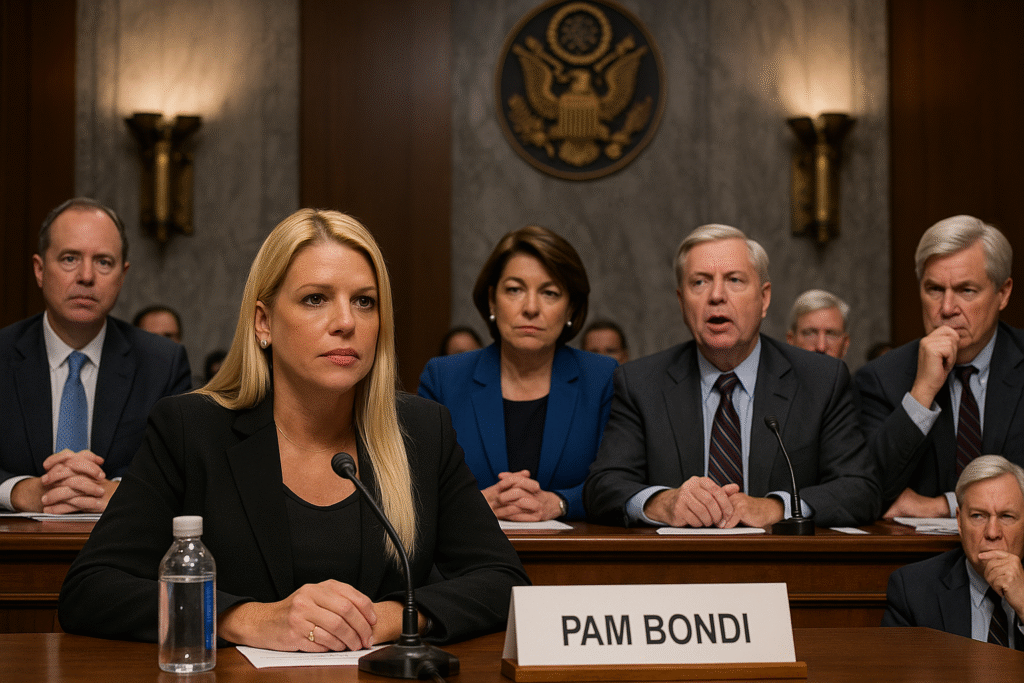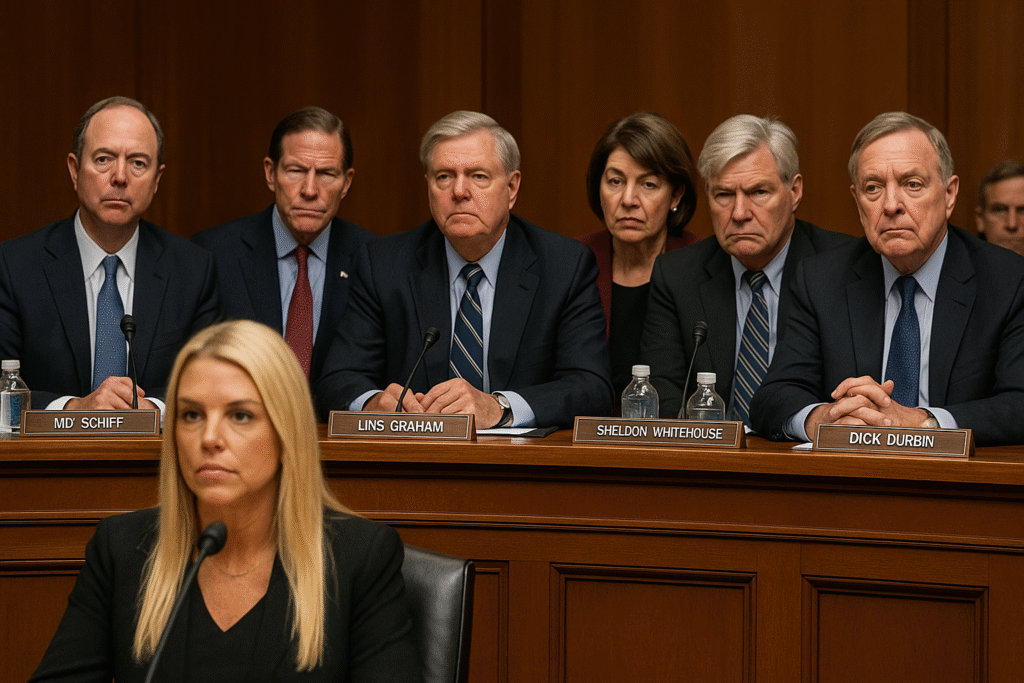Pam Bondi Hearing: This long-form explainers runs you through the Oct–2025 Senate Judiciary oversight hearing with Attorney General Pam Bondi, the major exchanges involving senators such as Adam Schiff, Richard Blumenthal, Lindsey Graham, Amy Klobuchar, Sheldon Whitehouse and Dick Durbin, and what the hearing means for justice, politics and everyday Americans.
Why this hearing matters right now
Pam Bondi Hearing: Attorney General Pam Bondi’s appearance before the Senate Judiciary Committee drew unusually intense attention because it combined criminal investigations of political figures, questions about Department of Justice independence, and widely watched public exchanges between the AG and senior senators. The hearing was livestreamed and archived on C-SPAN for public review, so citizens can watch the record directly.
Public oversight of the Justice Department is a constitutional and democratic norm: hearings like this shape public trust, set congressional expectations of DOJ behavior, and sometimes trigger follow-up investigations or policy changes depending on what is revealed. That practical importance is why coverage landed at the top of major outlets on Oct 7, 2025.
Quick snapshot: who’s who (short primer)
Pam Bondi is the 87th U.S. Attorney General, sworn in earlier in 2025 after a career that included two terms as Florida attorney general. The Department of Justice maintains a public profile and staff page for the AG.
Adam Schiff — now a U.S. senator from California following his 2024 election — has emerged as a leading Democratic voice on intelligence, oversight and rule-of-law issues; he participated actively in the Senate exchanges.
Senator Richard Blumenthal (CT), Senator Dick Durbin (IL), Senator Sheldon Whitehouse (RI), Senator Amy Klobuchar (MN) and Senator Lindsey Graham (SC) are all senior Judiciary Committee figures whose lines of questioning shaped the hearing’s narrative. Each brought familiar priorities to their time with the AG: institutional independence, accountability, civil rights enforcement and national security.

1 — What happened at the hearing (high-level sequence)
Bondi’s testimony began with opening remarks defending the Justice Department’s direction under her leadership. She framed her work as resetting priorities and promised to pursue “real crime” while rejecting what she called politicization complaints. Democrats countered with specific, partisan and non-partisan concerns about investigations, staff changes and policies that critics say erode institutional independence.
The hearing quickly turned contentious when senators pressed Bondi on prosecutorial decisions involving high-profile figures, the department’s handling of Jeffery Epstein-related records, and allegations of favoritism or selective enforcement. Several exchanges were heated enough to make headlines on cable and in press coverage.
2 — Notable exchanges: Bondi vs. Blumenthal, Durbin and others
Senator Richard Blumenthal pressed Bondi on the department’s handling of past investigations and sought clarity on whether political considerations affected prosecutorial choices. Bondi replied forcefully in places, at one point accusing some questioning senators of mischaracterizations — an approach that amplified the partisan tone.
Senator Dick Durbin — the committee’s ranking Democrat — rebuked Bondi over what he described as a pattern of undermining the DOJ’s integrity, particularly when career prosecutors are removed or investigations are narrowed. Durbin’s comments reflected broader Democratic concerns about institutional norms.
Republican committee members, including Senator Lindsey Graham, offered qualified defense of Bondi’s right to set prosecutorial priorities while still asking for clear public rules to avoid perceptions of favoritism. That mix of defense and demands for transparency is a familiar posture when an AG from the president’s party takes tough questions.
3 — Adam Schiff’s role and line of inquiry
Senator Adam Schiff pressed on points linking national-security procedures, classified-information handling and the DOJ’s independence when political actors are subject to inquiry. Schiff — now a senator representing California — emphasized legal norms and asked for documentary clarity where cases intersect with national-security protocols. His contributions reflected his prior leadership on oversight while in the House.
Schiff’s questions were not purely political posturing; they reflected substantive, procedural worries that legal scholars and practitioners have raised when prosecutorial discretion overlaps with high-profile political figures and classified materials. The senator repeatedly asked for concrete assurances and records.
4 — Epstein files, Comey, and other flashpoints
A recurring theme at the hearing was how the DOJ handles sensitive historical investigations — notably files related to Jeffrey Epstein and inquiries that touched former FBI Director James Comey. Democrats sought explanations and possible remedies; Bondi largely resisted detailed public disclosures, citing ongoing matters or prosecutorial discretion. That push-and-pull is a typical oversight tension: transparency vs. operational confidentiality.
These flashpoints have both judicial and public-opinion consequences: mishandled disclosures can undercut confidence, while excessive secrecy can fuel distrust. Senators from both parties tried to frame their demands as protecting institutional credibility, even when they disagreed about the AG’s performance.

5 — C-SPAN and public record: watch it yourself
The entire session was webcast and archived on C-SPAN, so readers can review the exchanges in full and form their own judgments. Public access to hearings like this is crucial for civic oversight and helps reporters, scholars and citizens cite exact language — which is why C-SPAN links and committee transcripts are part of the official public record.
If you want to quote testimony or assess procedural claims, start with the C-SPAN archive and the Senate Judiciary Committee docket — both are primary sources that preserve the hearing’s verbatim record.
6 — What each party wants from the hearing
Democrats used the hearing to press for safeguards: independent inspectors general reviews, clearer protocols for removing career prosecutors, and public release of non-sensitive documents to restore trust. Republicans emphasized prosecutorial focus on violent crime and alleged past “weaponization” of the DOJ against conservatives; they defended the AG’s latitude to set priorities. The resulting policy debate is the immediate political product of the hearing.
Because the Senate is the forum for oversight, the hearing’s next steps could include subpoenas, letters demanding documents, or invitations for further briefings — depending on what committee leaders decide after reviewing the record. Expect follow-up actions in the short term.
7 — What this means for the Justice Department and courts
Beyond partisan headlines, oversight hearings feed into real administrative and legal results: Office-level reforms, changes in internal guidance for prosecutors, and sometimes test cases that clarify legal standards. If the committee identifies systemic issues, it can press for legislative fixes or new oversight mechanisms. For the public, those changes affect prosecutorial fairness and the pace and scope of enforcement across the country.
The DOJ’s reputation matters for cooperation with state authorities, international legal partners and witness willingness to come forward — so procedural questions about independence are not just academic; they have practical ripple effects.
8 — How to interpret media coverage: read the record
Major outlets (Reuters, Washington Post, The Guardian and others) offered summaries and analysis; those reports are valuable but inevitably frame the hearing through editorial lenses. If you want to separate summary from primary record, watch the C-SPAN video and read the committee transcript first, then compare reporting to the source. That layered approach reduces the chance of misreading a single soundbite as comprehensive.
9 — Bottom line for citizens (short guide)
- Watch the record: C-SPAN archived the hearing and the transcript will be available on the Senate Judiciary site. That’s the primary source for any factual claim.
- Look for follow-ups: Oversight hearings rarely end the story — expect letters, document requests or additional testimony.
- Ask representatives: If you want action (e.g., IG review or legislative changes), contact your senators and ask what they will do next. Congressional oversight is driven by constituent engagement.
- Stay skeptical but civic-minded: Distinguish between partisan framing and procedural claims that have measurable consequences for justice and rule of law.
FAQ (fast answers)
Q: Did Bondi admit wrongdoing or lawbreaking?
A: No. Bondi defended DOJ choices and denied politicization; she pushed back on pinning operational decisions to personal or political motives. Media coverage captured the exchanges; the C-SPAN archive and committee transcript are the final word for exact phrasing.
Q: Which senators were most forceful?
A: Democrats including Dick Durbin, Richard Blumenthal and Adam Schiff were especially pointed on institutional independence; Republicans such as Lindsey Graham took a mix of defense and calls for clearer policy.
Q: Will the hearing change prosecutions?
A: Not immediately. But oversight can trigger policy changes, document releases or IG probes that have downstream effects. That’s the mechanism to watch.
Sources — verified links (read primary sources & major reporting)
Below are the valid, authoritative sources used to compile this article. Click to read the original reporting, the C-SPAN video and official profiles.
- C-SPAN — Attorney General Pam Bondi testifies to the Senate Judiciary Committee (video archive). (C-SPAN)
https://www.c-span.org/event/senate-committee/attorney-general-pam-bondi-testifies-to-senate-judiciary-committee/436860 - U.S. Department of Justice — Meet the Attorney General (official profile of AG Pam Bondi). (Department of Justice)
https://www.justice.gov/ag/staff-profile/meet-attorney-general - Reuters — “Bondi rebukes Democrats as she faces criticism over DOJ leadership.” (Oct 7, 2025). (Reuters)
https://www.reuters.com/legal/government/bondi-says-doj-ending-weaponization-justice-it-pursues-trump-critics-2025-10-07/ - The Washington Post — “A combative Bondi clashes with senators on Epstein, cases against Trump foes.” (Oct 7, 2025). (The Washington Post)
https://www.washingtonpost.com/national-security/2025/10/07/bondi-senate-hearing-epstein-comey/ - Senator Adam Schiff — official Senate page and biography. (Senator Schiff)
https://www.schiff.senate.gov/ - Senator Richard Blumenthal — official site/bio. (Richard Blumenthal)
https://www.blumenthal.senate.gov/about/biography - Senator Amy Klobuchar — official biography. (Klobuchar Senate)
https://www.klobuchar.senate.gov/public/index.cfm/about-amy - Senator Sheldon Whitehouse — official site. (Senator Sheldon Whitehouse)
https://www.whitehouse.senate.gov/ - Senator Dick Durbin — official biography. (Senator Dick Durbin)
https://www.durbin.senate.gov/about-dick-durbin
Disclaimer
This article summarizes primary hearing recordings and reputable reporting available as of October 2025. It is intended for informational purposes only and is not legal advice. Trenbuzz.com and the author rely on the public record and reputable news outlets; readers are encouraged to consult the linked primary sources (C-SPAN video, committee documents, and official bios) for full context.
